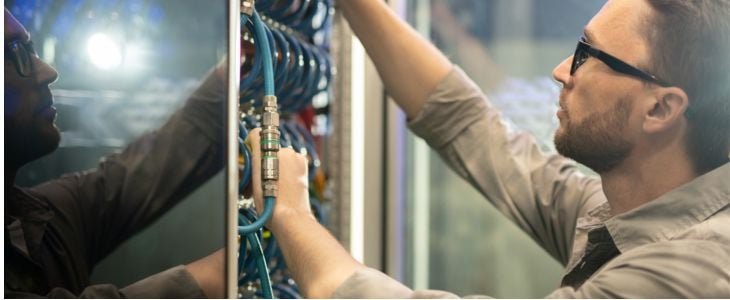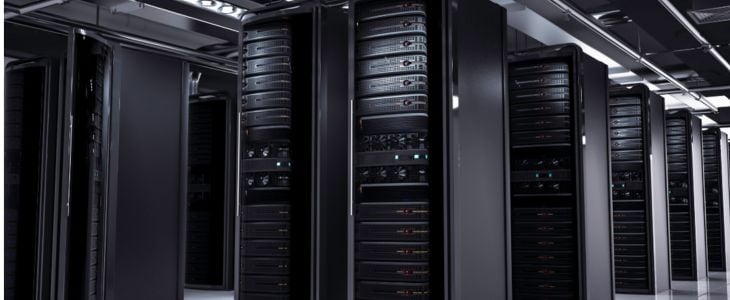Developing a green data center has become a necessity as the importance of these installations extends beyond the merely technical. While data centers establish themselves as pivotal structures for global development, the achievement of a sustainable data center remains key.
With substantial energy demands for operation and the need to develop efficient cooling technology to safeguard equipment, data centers present a particularly interesting field for achieving sustainability. And, at the center of this need, lies energy efficiency.
As the global data center market is expected to grow at a CAGR of 7.5% in the next decade, according to consultant firms such as Globe Newswire, let’s look at how future green data center models will look like.
Green data center: a definition
A green data center can be defined as a facility that hosts servers to store, manage, and disseminate data that has been designed to be highly energy efficient and to minimize its environmental impact.
The green data center is regarded as the only possible model for what the future of data center technologies will look like. As the demand for data storage continues growing, operators have seen an extended demand for power and their cooling systems. In such a context, future data centers must prioritize sustainability.
Two metrics have been developed to provide a more objective definition of what a green data center is or, in other words, to measure the efficiency of a data center:
-
Power Usage Effectiveness (PUE): developed by The Green Grid, it measures power consumption of a data center and provides the ratio of the amount of power used by a data center to the power delivered to its equipment. A ratio of 1.0 signifies a sustainable data center where all power is delivered to IT equipment.
-
Carbon Usage Effectiveness (CUE): again developed by The Green Grid, it looks at the data center’s ratio of total CO2 emissions and divides it by the energy consumption of IT equipment. A green data center will present the lowest possible value.
Additionally, several certifications have been developed in order to, again, provide an objective framework to define sustainable data center practices. Such is the case of the Leadership in Energy and Environmental Design (LEED), which grants data centers a silver, gold or platinum certification depending on their achievements in terms of green construction. The National Data Center Energy Efficiency Information Program by Energy Star, represents another U.S. initiative capable of certifying buildings and consumer products for their energy efficiency.

How to achieve a green data center: key strategies
When it comes to developing a green data center, energy use remains the key issue to solve. On the one hand, it’s advisable for operators to switch to renewable energies and minimize their carbon emissions.
On the other hand, achieving energy efficiency remains crucial. There are several ways to do this:
1. DCIM software:
These tools are in charge of providing information about a data center’s energy use and managing smartly in order to minimize energy consumption without risking operational efficiency.
2. Optimized cooling technology:
Cooling solutions in data centers are in charge of maintaining adequate technologies for the IT equipment to run safely. The choice of cooling technologies, as we see below in the text, can greatly affect a center’s energy efficiency. The achievement of optimal cooling can take many shapes and forms for each data center, as it must consider each project’s needs as well as its location. This is why the help of accomplished cooling engineering experts is required to guarantee each project has access to the right solution.
3. Waste-heat recovery structures:Data centers typically release heat caused during their operation, generating a significant negative environmental impact. However, certain structures are able to reuse this heat emission, turning waste into climate-positive energy consumption and building a green data center that is also cost-efficient.
Such is the case of Thermal Energy Storage (TES) tanks, which are able to act as thermal accumulators that facilitate the storage of heat to use it later.
4. Modular and fully-integrated plants
Develop sustainable and efficient data center models through modular and integrated plants. Designed with efficiency as a goal, they provide scalability by avoiding costly and complex installation processes when they’re not necessary.

The choice of cooling technology: key in energy efficiency
Data center cooling technology not only determines the center’s operational cost, but also plays a major role in its reliability and capacity to become energy-efficient.
As electronic equipment emits heat during its operation, it needs adequate temperatures to ensure correct performance. Cooling technology solutions are thus implemented. However, the choice of the right data center cooling systems can make a significant difference.
At ARANER, we work to develop cooling technologies to generate the green data center models of the future. Our solutions include industrial-type chillers and robust control systems, to guarantee the right balance between a continuous and reliable supply of cooling energy and the lowest electrical consumption in the market.
Our cooling technology solutions are characterized by the following features:
-
Can adapt to guarantee data center redundancy while also adapting to TIER level requirements. This allows our systems to present the highest specifications from the industry but also adapt to each project’s requirements.
-
State-of-the-art equipment for energy optimization, including the incorporation of TES tanks.
-
Generation of fully-integrated systems through the development of our own control models for gathering all information regarding structures, equipment and elements. This includes using intuitive Human Machine Interfaces (HMI), SCADA’s and redundant EtherNet/IP and other common industrial communication protocols such Modbus, Profinet or BacNet.
-
The possibility to develop modular cooling plants both for new projects and retrofit projects, with a flexible, plug-and-play philosophy that maximizes energy efficiency.
Our team has been part of highly demanding projects and is available to provide expertise in different areas. This includes the generation of the right sustainable data center that responds both to governmental requirements as well as increasing cost-efficiency for operators.
We’re here to help you learn more about data center cooling technology possibilities and how to maximize your project’s efficiency without risking operational competence, developing the green data center model you’re looking for.
If you want to discover the current choices in data center cooling efficiency, download our free data center cooling reference ebook. We also encourage you to get in touch with us and speak directly to our team about your project’s specific needs and how we can help you achieve them.










